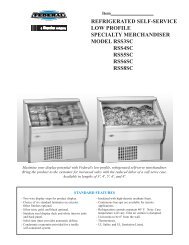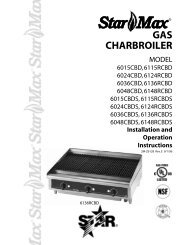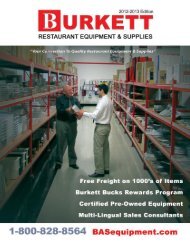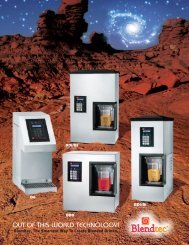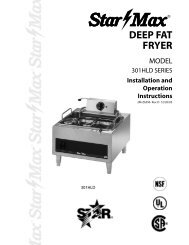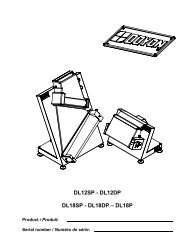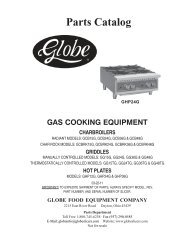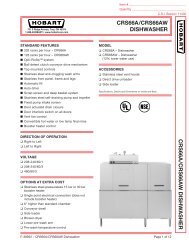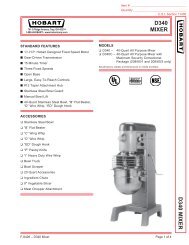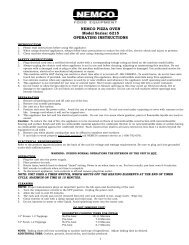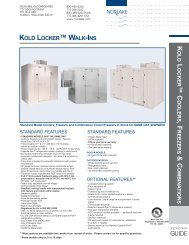ICE MACHINES Q-Model Service Manual
ICE MACHINES Q-Model Service Manual
ICE MACHINES Q-Model Service Manual
- No tags were found...
Create successful ePaper yourself
Turn your PDF publications into a flip-book with our unique Google optimized e-Paper software.
Refrigeration System Section 7HOW TO USE THE REFRIGERATION SYSTEMOPERATIONAL ANALYSIS TABLESGeneralThese tables must be used with charts, checklists andother references to eliminate refrigeration componentsnot listed on the tables and external items and problemswhich can cause good refrigeration components toappear defective.The tables list five different defects that may affect theice machine’s operation.NOTE: A low-on-charge ice machine and a starvingexpansion valve have very similar characteristics andare listed under the same column.NOTE: Before starting, see “Before Beginning <strong>Service</strong>”on Page 7-9 for a few questions to ask when talking tothe ice machine owner.ProcedureStep 1 Complete the “Operation Analysis” column.Read down the left “Operational Analysis” column.Perform all procedures and check all information listed.Each item in this column has supporting referencematerial to help analyze each step.While analyzing each item separately, you may find an“external problem” causing a good refrigerantcomponent to appear bad. Correct problems as they arefound. If the operational problem is found, it is notnecessary to complete the remaining procedures.Step 2 Enter check marks (√) in the small boxes.Each time the actual findings of an item in the“Operational Analysis” column matches the publishedfindings on the table, enter a check mark.Example: Freeze cycle suction pressure is determinedto be low. Enter a check mark in the “low” box.Step 3 Add the check marks listed under each of thefour columns. Note the column number with the highesttotal and proceed to “Final Analysis.”NOTE: If two columns have matching high numbers, aprocedure was not performed properly and/or supportingmaterial was not analyzed correctly.Final AnalysisThe column with the highest number of check marksidentifies the refrigeration problem.COLUMN 1 - HARVEST VALVE LEAKINGA leaking harvest valve must be replaced.COLUMN 2 - LOW CHARGE/TXV STARVINGNormally, a starving expansion valve only affects thefreeze cycle pressures, not the harvest cycle pressures.A low refrigerant charge normally affects both pressures.Verify the ice machine is not low on charge beforereplacing an expansion valve.1. Add refrigerant charge in 2 to 4 oz. increments as adiagnostic procedure to verify a low charge. If theproblem is corrected, the ice machine is low oncharge. Find the refrigerant leak.The ice machine must operate with the nameplatecharge. If the leak cannot be found, properrefrigerant procedures must still be followed Changethe liquid line drier. Then, evacuate and weigh in theproper charge.2. If the problem is not corrected by adding charge, theexpansion valve is faulty.On dual expansion valve ice machines, change onlythe TXV that is starving. If both TXV’s are starving,they are probably good, and are being affected bysome other malfunction, such as low charge.COLUMN 3 - TXV FLOODINGA loose or improperly mounted expansion valve bulbcauses the expansion valve to flood. Check bulbmounting, insulation, etc., before changing the valve. Ondual expansion valve machines, the service technicianshould be able to tell which TXV is flooding by analyzingice formation patterns. Change only the floodingexpansion valve.COLUMN 4 - COMPRESSORReplace the compressor and start components. Toreceive warranty credit, the compressor ports must beproperly sealed by crimping and soldering them closed.Old start components must be returned with the faultycompressor.7-24 Part No. 80-1100-3




